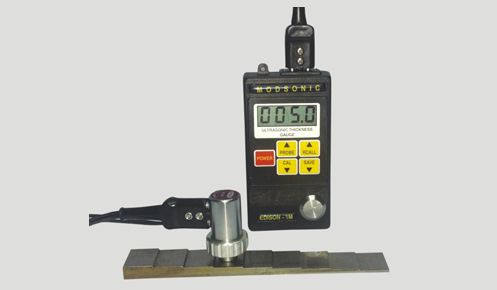In industries where material integrity is critical, ensuring the thickness of components and structures is essential for safety, performance, and cost-effectiveness. Ultrasonic thickness gauges have become an essential tool in industries like aerospace, manufacturing, oil and gas, and construction, offering a reliable and non-destructive method for measuring material thickness. This blog will explain how ultrasonic thickness gauges work, their applications across various industries, and the many advantages they offer in monitoring material health and preventing costly failures.
What is an Ultrasonic Thickness Gauge?
An ultrasonic thickness gauge is a device that measures the thickness of materials by sending high-frequency sound waves through the material and measuring the time it takes for the sound waves to return. By calculating the travel time of the sound waves and knowing the speed of sound in the material, the gauge can accurately determine its thickness. This method is non-destructive, meaning the material remains undamaged and can be inspected multiple times.
Ultrasonic thickness gauges are widely used in industries where materials are subject to wear, corrosion, or stress. These gauges help ensure that critical infrastructure and equipment are safe to operate, and they provide accurate readings that help prevent failures.
How Does an Ultrasonic Thickness Gauge Work?
The operation of an ultrasonic thickness gauge is based on the principle of sound wave propagation. Here’s a detailed breakdown of how the process works:
-
Signal Emission: The gauge’s transducer emits high-frequency ultrasonic pulses into the material.
-
Signal Travel: The sound waves travel through the material until they reach the far side.
-
Reflection: The sound waves reflect off the back surface of the material and return to the transducer.
-
Time Measurement: The gauge measures the time it took for the sound waves to travel through the material and reflect back.
-
Thickness Calculation: Using the time measurement and the known speed of sound in the material, the gauge calculates its thickness.
This process is fast, accurate, and non-destructive, making ultrasonic thickness gauges ideal for frequent inspections and real-time material monitoring.
Key Components of an Ultrasonic Thickness Gauge:
-
Transducer: The ultrasonic probe that emits and receives sound waves.
-
Couplant: A gel or liquid used to transmit sound waves from the transducer into the material being tested.
-
Display: A screen that shows the thickness reading, usually in millimeters or inches.
-
Power Source: Typically battery-powered for portability and ease of use in the field.
Types of Ultrasonic Thickness Gauges
There are several types of ultrasonic thickness gauges designed to meet the needs of different industries. These include:
1. Handheld Ultrasonic Thickness Gauges
Handheld models are compact and portable, designed for field inspections. These devices are used to quickly measure material thickness and provide immediate feedback, making them ideal for routine checks in industries like construction, manufacturing, and maintenance.
2. Digital Ultrasonic Thickness Gauges
Digital ultrasonic gauges offer more advanced features, such as data storage, detailed measurement logging, and the ability to generate reports. These gauges are suited for industries that require extensive data tracking and documentation, such as aerospace, automotive, and oil and gas.
3. Dual-Element Ultrasonic Thickness Gauges
Dual-element gauges feature two elements in the transducer—one for sending sound waves and another for receiving them. This design improves measurement accuracy, especially for thicker materials or those with rough surfaces. Dual-element gauges are commonly used in applications requiring high precision, such as pressure vessel inspections, aerospace components, and nuclear power plants.
4. Coating Thickness Gauges
Coating thickness gauges are specifically designed to measure the thickness of coatings like paint, galvanization, or anodization on metal surfaces. These gauges are commonly used in industries like automotive manufacturing, infrastructure, and construction, where protective coatings are essential for preventing corrosion.
Applications of Ultrasonic Thickness Gauges
Ultrasonic thickness gauges have a wide range of applications across various industries. Here are some of the primary uses:
1. Oil and Gas Industry
In the oil and gas sector, pipelines and storage tanks are essential components that are often exposed to harsh environmental conditions. Over time, corrosion can cause thinning of the material, making it unsafe to operate. Ultrasonic thickness gauges are regularly used to measure the remaining thickness of pipelines and tanks, allowing operators to detect areas of concern before a failure occurs. This early detection helps prevent spills, leaks, or explosions, ensuring the safety of personnel and the environment.
2. Aerospace Industry
Aerospace components, such as aircraft wings, fuselages, and engine parts, are exposed to extreme stresses and environmental conditions. Regular inspections with ultrasonic thickness gauges help ensure these parts remain within the required specifications and do not suffer from corrosion or material fatigue. Ultrasonic testing in aerospace is crucial for maintaining safety and meeting rigorous industry standards.
3. Manufacturing and Quality Control
Ultrasonic thickness gauges play a vital role in quality control during manufacturing processes. They are used to measure the thickness of raw materials and finished products, ensuring that components are within tolerances and meet safety and performance standards. For example, ultrasonic gauges can measure the thickness of metal sheets or parts used in automotive manufacturing, ensuring they are correctly produced and fit for use.
4. Shipbuilding and Marine Industry
In shipbuilding, where vessels are constantly exposed to saltwater, ultrasonic thickness gauges are essential for monitoring the thickness of the hulls and other critical components. Corrosion from seawater can thin metal parts, compromising the vessel’s integrity. By using ultrasonic gauges, shipbuilders can ensure that the structure of the ship is safe and can withstand the stresses of the marine environment.
5. Construction and Infrastructure
In the construction industry, ultrasonic thickness gauges are used to inspect steel reinforcements, beams, columns, and other metal components in buildings, bridges, and tunnels. These gauges help detect corrosion or degradation in steel, ensuring that the structure remains safe for public use. Ultrasonic testing allows for timely maintenance, preventing the need for costly and disruptive repairs later on.
6. Automotive Industry
The automotive industry uses ultrasonic thickness gauges to monitor the thickness of protective coatings, such as rustproofing and paint, applied to metal components. Ultrasonic gauges ensure that coatings are applied evenly and to the correct thickness, which helps protect the vehicle from corrosion and extends its lifespan. These gauges are also used in the quality control process to ensure that metal parts meet manufacturing specifications.
Benefits of Using Ultrasonic Thickness Gauges
Ultrasonic thickness gauges offer several significant advantages, which is why they are widely adopted in industries that rely on material integrity. Some of the key benefits include:
1. Non-Destructive Testing (NDT)
One of the biggest advantages of ultrasonic thickness gauges is that they are non-destructive. This means that the material being tested is not altered or damaged during the measurement process, allowing for repeated testing without compromising the structure. This is especially beneficial for critical infrastructure and equipment that must remain in service during inspections.
2. High Accuracy and Precision
Ultrasonic thickness gauges are highly accurate and provide reliable, repeatable measurements. The precision offered by these devices ensures that even minor changes in material thickness, such as corrosion or wear, are detected early. This is crucial for industries where material degradation can lead to catastrophic failures, such as aerospace, oil and gas, and manufacturing.
3. Cost-Effective Maintenance
By detecting material thinning, corrosion, or wear early, ultrasonic thickness gauges help identify issues before they result in costly repairs or equipment replacements. Preventive maintenance can be scheduled based on these early warnings, reducing the likelihood of unplanned downtime or failures. This proactive approach can save businesses significant amounts of money in the long run.
4. Portability and Ease of Use
Most ultrasonic thickness gauges are lightweight, portable, and easy to use. This makes them ideal for field inspections in remote locations or hard-to-reach areas. Many models feature intuitive controls and digital displays that allow technicians to quickly obtain readings and make informed decisions. This ease of use makes ultrasonic gauges suitable for both experienced professionals and those with less technical training.
5. Versatility
Ultrasonic thickness gauges are versatile tools that can be used on a wide range of materials, including metals, plastics, and composites. This versatility makes them suitable for a variety of industries, including aerospace, automotive, oil and gas, and manufacturing. Ultrasonic gauges can also measure a broad range of thicknesses, from thin coatings to thicker materials, making them adaptable for various applications.
6. Improved Safety and Compliance
By providing accurate measurements of material thickness, ultrasonic gauges help ensure that equipment and infrastructure comply with safety regulations and industry standards. Regular testing and monitoring help prevent equipment failure, ensuring the safety of workers and the public. Ultrasonic testing also provides documentation that can be used for compliance reporting and audits.
Conclusion
Ultrasonic thickness gauges are essential tools for ensuring the safety, performance, and longevity of materials across a wide range of industries. Their ability to provide accurate, non-destructive measurements makes them indispensable for monitoring the integrity of critical infrastructure and equipment. Whether you’re monitoring the thickness of pipelines in the oil and gas industry, inspecting aircraft parts in aerospace, or ensuring the quality of coatings in automotive manufacturing, ultrasonic thickness gauges provide fast, reliable, and cost-effective solutions.
The portability, precision, and versatility of ultrasonic thickness gauges make them an invaluable asset for industries that rely on material integrity. By incorporating these tools into regular inspection routines, companies can reduce maintenance costs, prevent failures, and ensure the safety of their operations. With the added benefit of non-destructive testing, ultrasonic gauges offer a reliable way to manage assets, improve safety, and maintain compliance with industry regulations.



